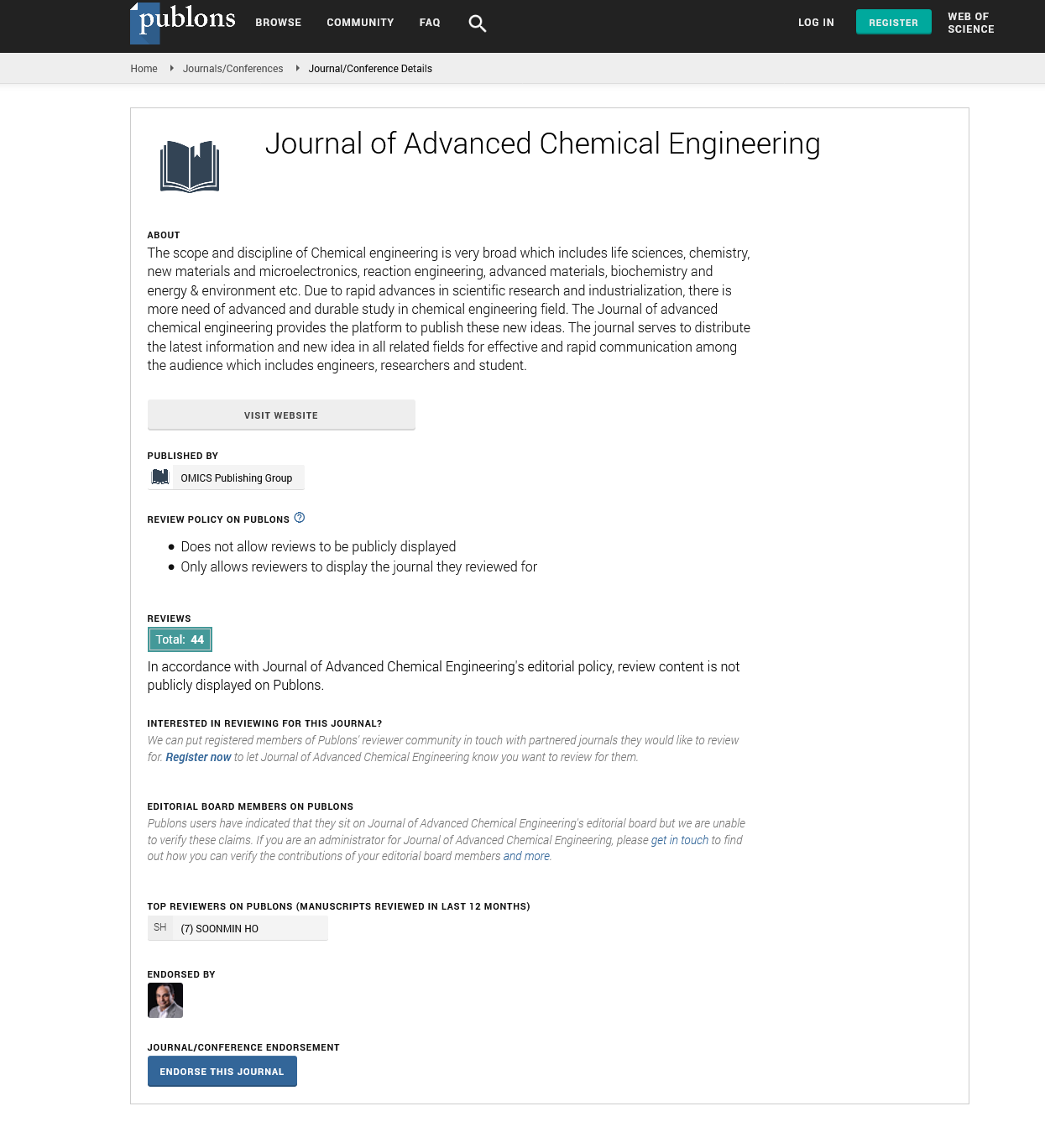Indexed In
- Open J Gate
- Genamics JournalSeek
- Smithers Rapra
- RefSeek
- Directory of Research Journal Indexing (DRJI)
- Hamdard University
- EBSCO A-Z
- OCLC- WorldCat
- Scholarsteer
- Publons
- Geneva Foundation for Medical Education and Research
- Google Scholar
Useful Links
Share This Page
Journal Flyer

Open Access Journals
- Agri and Aquaculture
- Biochemistry
- Bioinformatics & Systems Biology
- Business & Management
- Chemistry
- Clinical Sciences
- Engineering
- Food & Nutrition
- General Science
- Genetics & Molecular Biology
- Immunology & Microbiology
- Medical Sciences
- Neuroscience & Psychology
- Nursing & Health Care
- Pharmaceutical Sciences
Perspective - (2022) Volume 12, Issue 12
Chemical Technologies used in Chemical Industry
Fang Li*Received: 02-Dec-2022, Manuscript No. ACE-22-19354; Editor assigned: 07-Dec-2022, Pre QC No. ACE-22-19354 (PQ); Reviewed: 21-Dec-2022, QC No. ACE-22-19354; Revised: 26-Dec-2022, Manuscript No. ACE-22-19354 (R); Published: 04-Jan-2023, DOI: 10.35248/2090-4568.22.12.262
Description
Carbon dioxide is a promising source of carbon that is almost infinitely available for a variety of industrially significant purposes. The chemical exploitation of carbon dioxide should focus on creating added value and improving existing processes so that their overall carbon footprints are smaller. This study will talk about how carbon capture technologies are related and offer some broad standards for assessing the utilisation of carbon dioxide as a raw material.
While specialists from a variety of disciplines debate the viability of Carbon Capture and Storage (CCS) technology, interest in using carbon dioxide as a chemical feedstock is also reviving and expanding quickly. These methods are complimentary rather than competitive: The chemical exploitation of carbon dioxide tries to create value and create better and more efficient processes from a small portion of the waste stream, whereas CCS aims to capture and store enormous amounts of carbon dioxide. Carbon dioxide can be a promising carbon source with practically unlimited availability for a process, provided that the overall carbon footprint for the carbon dioxide-based process chain is competitive.
The metals from the soils are transferred into an aqueous solution via chemical extraction, which uses an extracting fluid containing a chemical reagent (acids/bases, surfactants, chelating agents, salts, or redox agent). The chemical extraction techniques known as "hydrometallurgy" in extractive metallurgy are widely used to recover metals from ores, concentrates, and recycled or residual materials.
In situ sensors that can monitor the chemical species used in the two main processes of primary production (photosynthesis and chemosynthesis) and respiration are greatly needed. O2, nutrients (N and P), micronutrients (metals), pCO2, dissolved inorganic carbon (DIC), pH, and sulphide are a few important chemical species. In addition to being free from fouling issues, sensors must have superior detection limits, precision, selectivity, response time, a wide dynamic concentration range, low power consumption, resilience, and reduced change of instrument response with temperature and pressure (biological, physical, and chemical). Here, we go through the general operating principles of marine sensors. We also demonstrate that while certain sensors are effective in only one environment due to various constraints, others can be utilised to detect the target chemical species in a variety of maritime settings. While many other sensors require water to be transported into a flow cell via tubing to the analyser in the environment or on board a ship, other sensors can be utilised fully in situ. Future research should concentrate on developing multi-element sensors that can measure a variety of chemical species in a single water mass.
The primary challenge we face in the new century is the shift from a consumer society driven solely by market and demand forces to a sustainable society driven by more realistic needs and natural resources; from a wasteful and destructive attitude toward the environment to one which respects the Earth as a finite and sensitive resource. As the mega-economies of the East inevitably converge on the standards and demands established in the Western world a century ago, it is imperative that we undertake this radical reevaluation of our relationship with the planet. At the same time, we must contend with an unprecedented rate of growth in resource demand.
Conclusion
Manufacturing chemicals faces the same difficulties as any other sector. The chemical industry, which was so successful for a large portion of the 20th century, is currently facing intense pressure to reform practically every aspect of its business practises. The amount of regulation impacting chemical production processes increased exponentially in the later years of the 20th century. This was partly a response to well-publicized chemical accidents like the Bhopal tragedy and to media and NGO focus on the sector. Additionally, energy expenses and hazardous waste disposal costs were increasing faster than the price of the things that manufacturing was producing.
Citation: Li F (2023) Chemical Technologies used in Chemical Industry. Adv Chem Eng.12:262.
Copyright: © 2023 Li F. This is an open-access article distributed under the terms of the Creative Commons Attribution License, which permits unrestricted use, distribution, and reproduction in any medium, provided the original author and source are credited.

